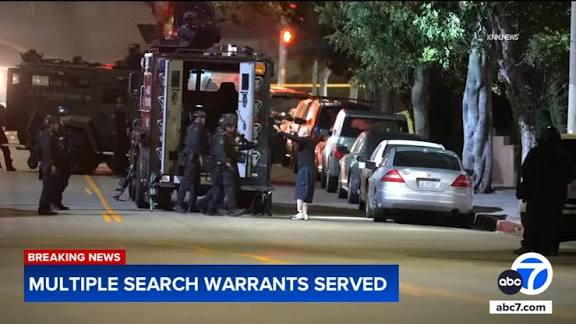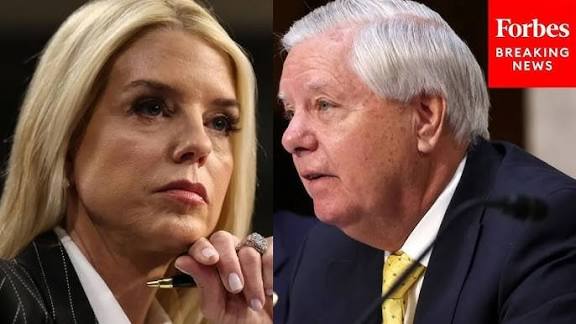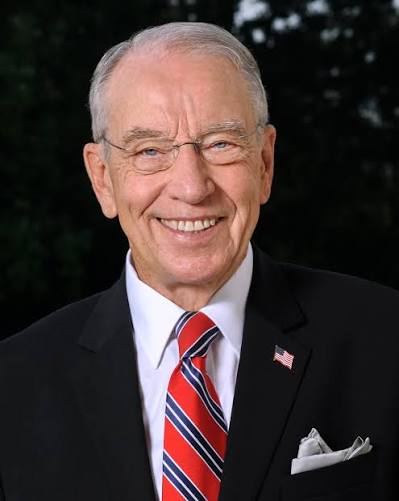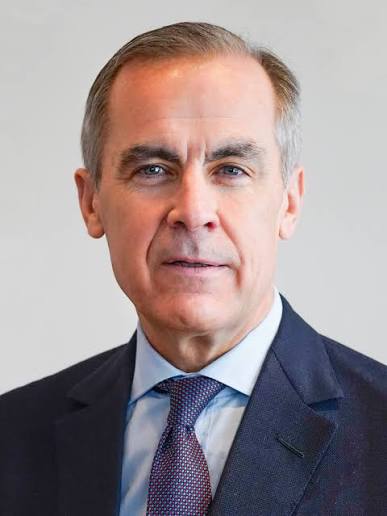Kai Trump Wears Her $130 Merch at White House: Private jet tour,Dunkin
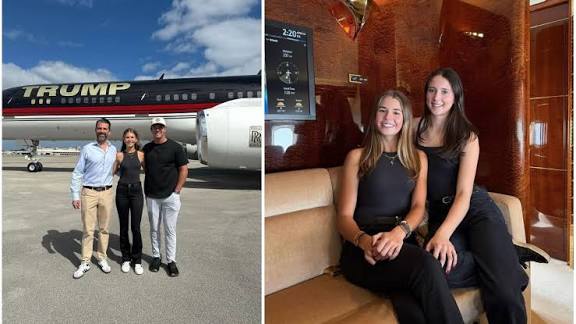
Kai Trump visited Donald Trump’s private jet with her grandfather to watch Elon Musk’s starship rocket launch. Today we will discuss about Kai Trump Wears Her $130 Merch at White House: Private jet tour,Dunkin
Kai Trump Wears Her $130 Merch at White House: Private jet tour,Dunkin
At just eighteen, Kai Trump—eldest daughter of Donald Trump Jr. and granddaughter of former President Donald Trump—is steadily becoming a figure in her own right. With a mix of ambitious branding, social media savvy, and high-visibility stunts, she is navigating life in the glare of public scrutiny. Recently, she has generated buzz by wearing her own $130 merchandise at the White House, giving tours of the family’s private jet, and even trying her hand at working a Dunkin’ drive-through. These varied moves raise questions: Is she building a brand, courting controversy, or positioning herself for a future role beyond being “Trump’s granddaughter”? Let’s unpack the details, reactions, and implications.
Background: Who Is Kai Trump?
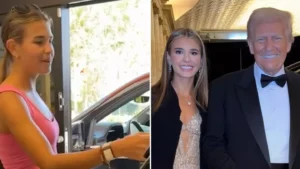
Before diving into the recent controversies, it helps to understand Kai’s profile and how she climbed into the public eye.
Kai Trump was born in 2007, making her 17–18 years old as of 2025. As the daughter of Donald Trump Jr. and Vanessa Trump, she belongs to the third generation of the Trump family. Over the past few years, she has developed a presence on social media (Instagram, TikTok, YouTube) and gained attention for her golfing pursuits. She has played varsity golf for her high school in Florida.
Her rise in public recognition accelerated after she gave a speech at the 2024 Republican National Convention. That speech, which was heartfelt and plainly personal, helped introduce her to a national audience beyond just being the president’s granddaughter.
From there, she has leaned into content creation: videos, brand collaborations, and a growing following. But her more recent moves suggest she is trying to expand into entrepreneurship—and perhaps brand-building in the mold of influencer-business crossover.
The $130 Merch & White House: Branding in the Halls of Power
One of the biggest stories that broke recently is Kai Trump wearing her own $130 merchandise on the White House grounds. She was photographed in a sweatshirt bearing her name or initials, while accompanying her grandfather on the South Lawn as they departed via Marine One.
The imagery is striking: a teenager, clearly in her own merch, walking across the lawn of the presidential residence. On social media, she described the collection as a long-time dream and emphasized the fabric, design, and wearability (i.e. not just “fan merch,” but something you’d wear beyond fandom).
From a brand-strategy perspective, leveraging the White House backdrop is bold: the prestige of the location lends visual weight to her clothing line. Yet it also invites ethical and political scrutiny. Critics wonder: Is she benefiting unfairly from association with her grandfather’s office? Is this thin ice between personal branding and official endorsement?
A White House spokesperson responded that there is no prohibition on taking pictures on White House grounds, and that such photos do not amount to a government endorsement of a private product. In earlier reporting, she had already used the White House for a photoshoot to launch the range on social media.
Still, the optics are potent. In some media quarters, this is seen as a continuation of a Trump family pattern: using high-profile political settings to bolster personal branding. (Recall how former President Trump once used the White House lawn to showcase a Tesla vehicle.)
The $130 price tag is also interesting. It signals an attempt to place her merchandise in a more premium bracket, rather than cheap fan gear. Whether the pricing aligns with consumer expectations or the quality of the garments remains to be tested in the marketplace and via reviews.
Inside Trump Force One: Private Jet Tours as Content
Another component of Kai’s public push is her use of the Trump family’s private jet, often dubbed “Trump Force One.” She has documented tours of the jet’s interior, offering fans a behind-the-scenes peek at a world few ordinarily see.
In a YouTube video, she shows off plush seating areas, a master bedroom with Trump crest pillows, and even the cockpit with a small Trump bobble-head. The jet is reportedly outfitted with luxury touches—gold detailing, upscale finishes, and custom interiors.
These videos serve multiple purposes:
-
Aspirational content: They underscore her proximity to wealth, power, and exclusivity.
-
Engagement magnets: Glimpsing the behind-the-scenes “lux life” is something that draws clicks and shares.
-
Brand reinforcement: The visuals reinforce that her brand is not just teenage fashion—they imply a lifestyle.
But this too carries risk. When everyday followers see this content, questions about privilege and fairness bubble up. Detractors might say she is exploiting public fascination with the ultra-wealthy. Supporters may argue it’s just savvy content creation—transparent, entertaining, and within her rights.
The Dunkin’ Stunt: Serving Coffee Behind the Counter
Perhaps the most playful of Kai’s recent moves is a TikTok video in which she attempted to work at a Dunkin’ Donuts drive-through. In the nine-second clip, she wears the brand’s signature pink and orange colors—a tank top and tennis skirt—and briefly takes an order, taps it into a register, and hands out a drink.
This was clearly a stunt, meant to promote a larger video in which she and her brother Tristan explore Dunkin’s menu and signature drinks. The stunt echoes a past moment when Donald Trump himself worked a McDonald’s counter during his 2024 campaign, which many critics dismissed as photo-op theater.
In media commentary, this move was described as “humble” or “quirky,” yet the framing is deliberate. Here’s what’s at stake:
-
Meme potential: Quick, easy to share, potentially viral.
-
Relatability angle: Even though she comes from privilege, she can drop into “everyday” jobs.
-
Promo tie-in: The stunt ties into her content pipeline (i.e. the full video or TikTok series).
On the flip side, cynics may see it as gimmicky or performative. It’s unlikely she’s truly substituting any serious work for her branding pursuits; it’s mostly content.
Public Reaction & Media Scrutiny
Kai’s recent moves have divided observers. Some see her as a deft young entrepreneur, leveraging her assets and platform to build a personal brand. Others view her as trading on privilege, walking a fine line between personal expression and inappropriate use of political proximity.
Here are some of the key criticisms and defenses:
Criticisms
-
Ethics & optics: Wearing your own branded merchandise on the White House lawns naturally invites questions about the boundary between public office and private gain.
-
Privilege inequality: Observers point out that how easily she can access these spaces and create content from them is a function of her family’s status—not something available to others.
-
Authenticity vs. performance: Stunt content like the Dunkin’ video may come off as calculated rather than genuine. Some might question whether she’s performing humility rather than embodying it.
-
Blurred lines: The balancing act between “influencer” and “political family member” is delicate; missteps might feed into accusations of impropriety or undue advantage.
Defenses
-
Creative expression: As a teenager with a big social following, launching a merchandise line is well within entrepreneurial norms.
-
Disclaimer & boundaries: The White House statement that the photos do not constitute endorsement is an official buffer.
-
Transparency: The content is out in the open, visible to all rather than hidden.
-
Building a future: If she intends to have a public-facing career—whether in media, business, or politics—she must carve her niche and reputation early.
Strategic Takeaways: What Kai Is Trying to Build
To make sense of Kai’s trajectory, we can interpret her moves through a few strategic lenses.
1. Personal Brand as Product
Kai isn’t just selling clothing; she’s selling the idea of Kai Trump. The merch, the jet tour, the high-visibility stunts—all cohere into a persona of ambition, accessibility, and aspirational youth. In that sense, the product (the hoodie) is secondary to the brand identity it signals.
2. Content-Driven Monetization
Her approach aligns with modern influencer economics: grow awareness through content, then channel that traffic into revenue. Whether via merchandise, endorsements (she has deals tied to golf), or media opportunities, her content is the funnel. The jet tour videos generate interest, the merch leverages that interest, and stunts like Dunkin’ amplify reach.
3. Boundary Testing & Brand Capitalizing
By using the White House grounds or military helicopters, Kai is testing how far a private individual tied to political power can push brand exposure before criticism or rules impede her. If she can walk those boundaries now without serious blowback, it becomes a blueprint for future “political influencer” activity.
4. Long-Term Positioning
Kai Trump may be positioning herself for future roles—whether in media, activism, or even political life. Having a built-in platform, brand identity, and public familiarity at a young age gives her a launching pad. When she reaches adulthood, the transition into more serious endeavors might be smoother.
Risks Ahead & Potential Pitfalls
While Kai’s ascent is deliberate and visible, several risks loom:
-
Public backlash: Overuse of political settings to promote private products can attract accusations of corruption or exploitation.
-
Brand overexposure: If everything becomes a “stunt,” her brand might lose authenticity or fatigue the audience.
-
Regulatory constraints: There are rules around endorsing products in governmental or publicly funded spaces; crossing them could invite ethics investigations.
-
Privileged bubble: If her narratives are too detached from everyday reality, she may seem out of touch; critics might question how “relatable” she genuinely is.
-
Transition challenge: As she ages, small stunts may not suffice—she’ll need new depth, purpose, or domain credibility to sustain long-term relevance.
Conclusion: The Making of a Political–Influencer Hybrid
Kai Trump’s recent moves—wearing her own $130 clothing at the White House, touring a gilded private jet, and even working a Dunkin’ drive-through—seem eclectic, even contradictory. But viewed through the lens of brand building and audience cultivation, they form pieces of a broader strategy: to emerge not just as a member of a famous family, but as a force in her own right.
Much will depend on how she balances visibility with substance going forward. If she can convert fascination into trust, and stunts into meaningful projects, she may grow into an enduring public figure. If not, she may fade into the background of political celebrity.
Regardless, Kai Trump’s early branding experiment is a case study in how youth, social media, and legacy can collide—and how a new generation navigates the tightrope between personal ambition and public scrutiny.
How useful was this post?
Click on a star to rate it!
Average rating 0 / 5. Vote count: 0
No votes so far! Be the first to rate this post.
About the Author
usa5911.com
Administrator
Hi, I’m Gurdeep Singh, a professional content writer from India with over 3 years of experience in the field. I specialize in covering U.S. politics, delivering timely and engaging content tailored specifically for an American audience. Along with my dedicated team, we track and report on all the latest political trends, news, and in-depth analysis shaping the United States today. Our goal is to provide clear, factual, and compelling content that keeps readers informed and engaged with the ever-changing political landscape.
